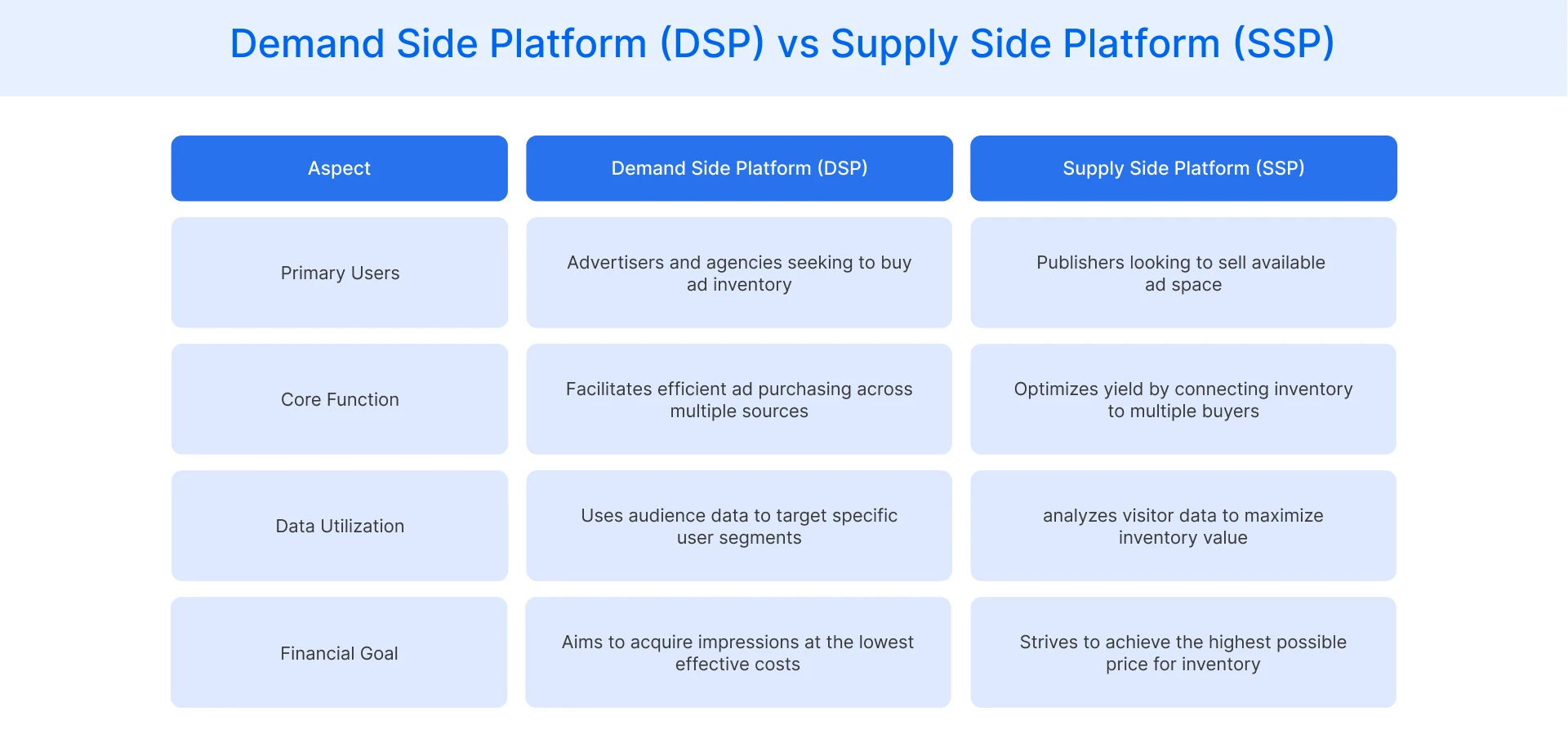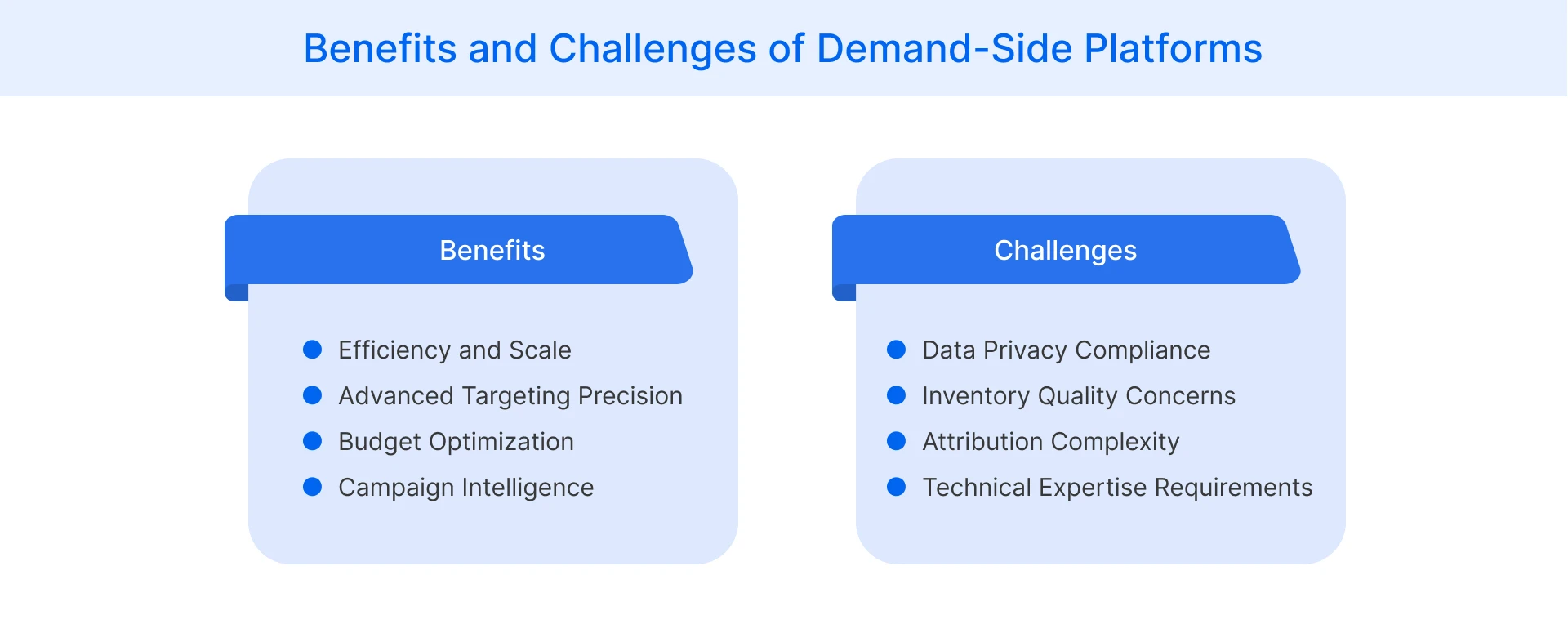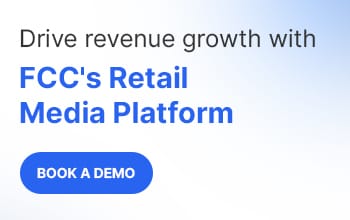Table of Contents
- What is a Demand Side Platform?
- How Does a Demand-Side Platform (DSP) Work?
- What Are the Types of Demand-Side Platforms?
- What is the Difference Between DSP and SSP?
- What are the Key Components of a DSP?
- What Features Should You Look for in a DSP?
- How Do DSPs Benefit Advertisers?
- What Challenges Do Advertisers Face When Using DSPs?
- Why are Demand-Side Platforms Important in the Advertising Ecosystem?
What is a Demand Side Platform?
A Demand Side Platform (DSP) provides advertisers with a powerful tool for navigating the intricate digital advertising landscape. This technology allows them to automate the buying of digital ad impressions across diverse channels. Advertisers gain access to a vast network of websites, apps, and other inventory sources.
DSP platforms play a pivotal role within the advertising technology ecosystem. They connect media buyers to supply-side platforms (SSPs) and ad networks. This connection facilitates real-time bidding for ad placements, optimizing ad campaigns. The platform helps advertisers efficiently acquire premium ad inventory.
These platforms are essential for modern advertisers seeking precision and scale. A Demand Side Platform simplifies media buying, making it more strategic. It empowers advertisers to reach specific audiences at opportune moments. This capability is crucial for maximizing advertising impact and return on investment.
How Does a Demand-Side Platform (DSP) Work?
The operational framework of a Demand Side Platform centers around automated bidding processes that occur in milliseconds whenever a user visits a website or application.
- When a user visits a publisher’s site, an ad request is sent to an ad exchange, triggering an auction for available ad space.
- The DSP evaluates the impression opportunity using pre-set targeting parameters, determining whether this user matches the target audience profile.
- The platform calculates a bid amount based on retargeting strategies and performance metrics like CTR and CPM.
- If the bid wins the auction, the advertisement appears on the user’s screen, creating an impression that happens instantaneously.
- Throughout this process, the DSP collects performance data to optimize future bidding strategies for similar audience segments.
- The platform continuously refines its algorithms based on campaign performance, ensuring advertising budgets are allocated to the most effective placements
What Are the Types of Demand-Side Platforms?
Demand Side Platforms vary in structure and operation, primarily dividing into self-serve and full-service models alongside specialised platforms that focus on specific channels or advertising formats.
Self-serve DSPs
Self-serve DSPs provide advertisers with direct control over their campaign management. They empower users to set up, launch, and optimize campaigns autonomously, ideal for those with in-house expertise.
- These platforms feature user-friendly interfaces for campaign setup.
- Advertisers maintain full control over budget allocation and targeting.
- They manage their own creative assets and campaign deployment.
- This option suits businesses seeking flexibility and direct operational control.
- It can potentially reduce the reliance on external ad agencies.
- Full-service DSPs
Full-service DSPs offer comprehensive campaign management, with the programmatic advertising platform provider handling all operational aspects. They provide expert support and strategic guidance, benefiting advertisers who prefer outsourced solutions.
- The DSP provider manages all aspects of campaign execution.
- They leverage specialized expertise for optimal campaign performance.
- Advertisers receive end-to-end support, from strategy to reporting.
- This option is beneficial for businesses with limited internal resources.
- It often provides access to advanced features and in-depth insights.
What is the Difference Between DSP and SSP?
Demand-Side Platforms (DSPs) and Supply-Side Platforms (SSPs) operate on opposite ends of the programmatic advertising ecosystem, serving distinct user bases with complementary functions. DSPs help advertisers buy ad inventory efficiently across multiple publishers, while SSPs assist publishers in selling their ad space to the highest bidder through automated processes.

What are the Key Components of a DSP?
An effective Demand Side Platform is built upon several critical components that empower advertisers to execute successful programmatic campaigns:
- Bidding Engine: The algorithmic core that evaluates impression opportunities in real time, determining appropriate bid amounts based on campaign parameters and historical performance data.
- Data Management Integration: Connections to first-party and third-party data sources that enhance targeting capabilities, allowing advertisers to reach specific audience segments based on demographics, interests, and behaviors.
- Creative Management System: Tools for uploading, storing, and deploying various ad formats across campaigns, with capabilities for dynamic creative optimization that personalizes content for different audience segments.
- Campaign Management Interface: Comprehensive dashboard where campaign parameters are established, including targeting criteria, budget allocation, bid strategies, and scheduling across multiple channels and formats.
- Analytics and Reporting Framework: Performance measurement tools that track key metrics such as impressions, clicks, conversions, and return on ad spend, providing actionable insights for campaign optimization.
What Features Should You Look for in a DSP?
Advertisers should evaluate the following key functionalities to ensure the platform meets their specific needs:
- Comprehensive inventory access across premium publishers, ad exchanges, and supply-side platforms ensures maximum reach potential across relevant audiences and environments.
- Advanced audience targeting capabilities utilizing both first-party and third-party data sources enable precise segmentation based on demographics, behaviors, and purchase intent.
- Transparent fee structures and clear billing practices help advertisers understand exactly what portion of their budget goes toward actual media versus platform costs.
- Cross-device and cross-channel capabilities allow seamless campaign execution across desktop, mobile, connected TV, audio, and emerging digital environments from a unified interface.
- Robust reporting dashboards with customizable metrics and actionable insights provide the necessary visibility to evaluate performance and make data-driven optimization decisions.
How Do DSPs Benefit Advertisers?
DSPs offer numerous advantages, transforming how advertisers manage their digital campaigns:
- Efficiency and Scale: The consolidation of multiple ad exchanges and inventory sources into a single platform eliminates the need for separate relationships with individual publishers. This reduces administrative overhead while expanding potential reach.
- Advanced Targeting Precision: DSPs leverage sophisticated data processing capabilities to identify and reach specific audience segments based on demographics, interests, behaviors, and contextual factors, significantly reducing wasted impressions.
- Budget Optimization: Real-time bidding algorithms continuously analyze performance data to allocate spending toward the most effective placements, automatically adjusting bid strategies to achieve lower costs per acquisition and higher overall return on ad spend.
- Campaign Intelligence: Comprehensive analytics provide actionable insights about audience behaviors, creative performance, and conversion patterns. This enables advertisers to refine their marketing strategies based on verified engagement data rather than assumptions.

What Challenges Do Advertisers Face When Using DSPs?
While Demand Side Platforms offer significant benefits, advertisers may encounter certain challenges.
- Data Privacy Compliance: Evolving regulations like GDPR, CCPA, and the deprecation of third-party cookies create obstacles for audience targeting, requiring advertisers to develop consent-based strategies and first-party data alternatives.
- Inventory Quality Concerns: An advertiser's own programmatic advertising technology ecosystem contains varying levels of fraudulent traffic and brand safety risks, necessitating robust verification tools and pre-bid filtering to prevent association with inappropriate content.
- Attribution Complexity: Multi-touch customer journeys spanning numerous devices and channels make it difficult to determine which impressions genuinely influenced conversion decisions, potentially leading to suboptimal budget allocation.
- Technical Expertise Requirements: Effectively managing DSP campaigns demands specialized knowledge of programmatic mechanics, bidding strategies, and data analysis techniques that many enterprises lack internally or struggle to develop.
Why are Demand-Side Platforms Important in the Advertising Ecosystem?
Demand-Side Platforms are indispensable in the modern digital advertising ecosystem, fundamentally transforming how ad inventory is bought and sold. They embody the shift towards automation, allowing advertisers to execute campaigns with unprecedented speed and scale. This efficiency is critical for navigating the increasingly complex and fragmented online media landscape, ensuring real-time opportunities are captured.
A DSP drives the evolution towards more data-driven advertising approaches. By integrating vast amounts of data, DSPs empower advertisers to gain deeper audience insights and refine their targeting strategies. This capability enables highly personalized ad experiences, moving beyond broad demographics to reach individuals with tailored messages, significantly enhancing campaign relevance.
The importance of DSPs also lies in their role in creating a more transparent and accessible programmatic marketplace. They connect advertisers to a wide array of publishers and ad exchanges, fostering healthy competition. This centralized access democratizes advertising, making sophisticated ad buying strategies available to a broader range of businesses, not just large enterprises.
FAQ
DSPs are developing alternative targeting methods focused on first-party data, contextual signals, and cohort-based approaches. Platforms are establishing direct publisher relationships to access authenticated user information while enhancing probabilistic matching capabilities that maintain effectiveness without cross-site tracking identifiers.
Mobile-specific DSPs offer specialized targeting using device identifiers, location data, and in-app behaviors. They provide deeper integration with mobile measurement partners, enhanced creative formats designed for mobile environments, and granular controls for targeting based on mobile engagement patterns.
Small businesses can access programmatic advertising through self-serve DSPs offering lower minimum spends and simplified interfaces. Many providers deliver scaled-down versions with essential features and educational resources, allowing smaller advertisers to compete effectively without extensive technical knowledge.
Demand Side Platforms implement consent management systems that track user permissions across websites and apps. They integrate with industry compliance frameworks while employing data minimization practices and enhanced security protocols to ensure all targeting activities remain within regulatory boundaries.

